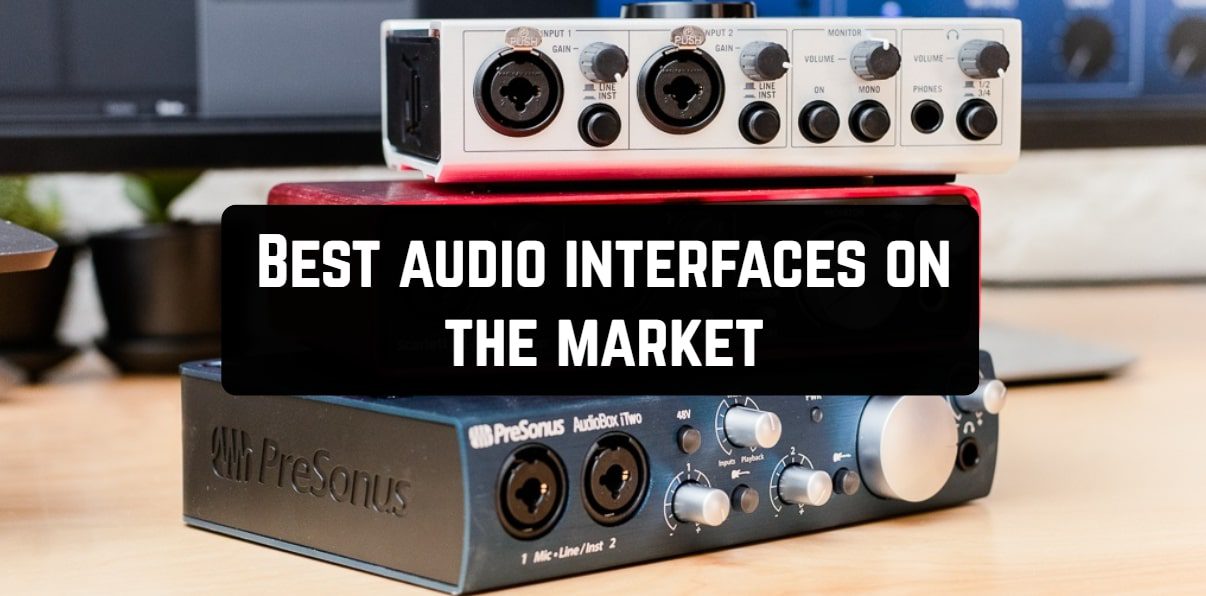High-quality recording in a home studio environment needs an appropriate financial investment. The main part of the budget will be spent not on the buy of monitors and quality switching, but on the buy of a productive audio interface.
Those who are going to buy the audio interface should decide on the budget and the list of sound card features.
Think about how many inputs and outputs you will need, which instruments and devices you will connect, and which music to record. Based on this information, it will be much easier to select a list of suitable models.
This overview shows you the best audio interfaces on the market. They fit any price category and have many different features.
Focusrite Scarlett 2i2
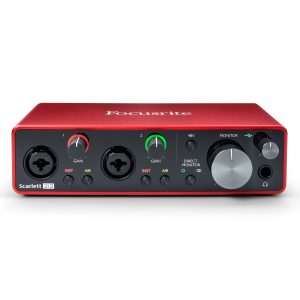
It is produced by one of the most famous British manufacturers of studio equipment Focusrite. The Scarlett line has replaced not less popular Saffire.
From year to year, it does not stop breaking sales records around the world. The 2i2 model, along with the Solo, is the youngest in the series.
It offers a compact design and low weight, matched with its signature sound quality. To connect the audio interface to a computer, a USB port is used and power is supplied.
Using the Cirrus Logic CS4272 chip, the card supports 24-bit / 96 kHz resolution.
For switching, a pair of 1/4″ TRS output connectors and two combined 1/4″ TRS and XLR input connectors from Neutrik are used.
Each input is provided with a line or instrument switch and sensitivity control. Phantom power is also available to operate condenser microphones.
There is also Direct Monitoring and very decent preamplifiers. They have always been Focusrite’s strong points. There is a built-in headphone amplifier with independent volume control and a large potentiometer. It handles the signal level at the line output.
Check also Top 12 microphone preamps for any budget
Steinberg UR12
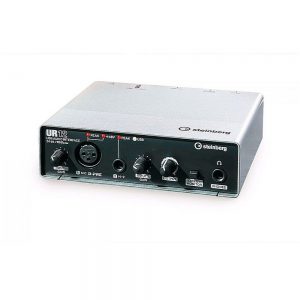
In a small metal case weighing 850 grams, there is a modern device with excellent sound characteristics.
The presence of Cirrus Logic CS4270 chip provides support for resolutions up to 24 bits / 192 kHz.
The amplifier stage is handled by the JRC 2068 EA and the headphone stage by the JRC 4580 EA.
Nichicon audiophile capacitors are also used in the circuit. The outputs are implemented on RCA connectors and two inputs.
Guitar output on 1/4″ TRS and microphone output on XLR. MIC D-PRE developed by Yamaha is used as a preamplifier. There are phantom power and a Direct Monitoring button.
It outputs the input signal directly to the output. There is also a headphone amplifier.
Among the interesting features of the card is the ability to use not only with a computer but also with an iPad. For this purpose, there is an extra micro-USB connector on the back panel.
A mobile device is connected to it using the Camera Connection Kit or Lightning to USB Camera Adapter. The main USB port must be connected to the network.
So that the device does not drain the tablet’s battery quickly. This sound card is one of the best budget solutions for listening to hi-res audio or creating a small project studio.
PreSonus AudioBox iOne
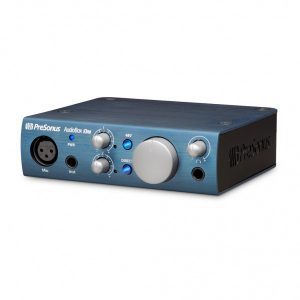
But, they have managed to prove an excellent combination of high quality and affordable price. The AudioBox range refers to inexpensive portable solutions.
They allow you to take your device with you anywhere. The iOne model features iPad support, which is clearly indicated by the letter i in the title.
It connects in the same way as Steinberg does. The usual USB port is used to connect to computers and notebooks.
Outputs are on 1/4″ TRS, and inputs are microphone on XLR and instrumental on 1/4″ TRS. The built-in preamplifier works in Class A.
It provides high signal strength and minimal noise. There is also phantom power, Direct Monitoring, and a headphone amplifier.
The regulators feature a pair of potentiometers to adjust input signal levels and one to change output volume. The unit is constructed in a robust metal housing.
It protects the device from accidental damage during transport. The sound quality of its class is very good even here.
Alva Nanoface
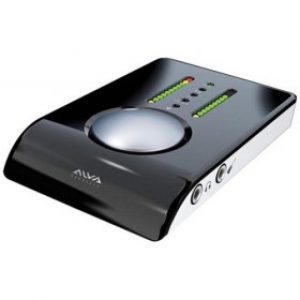
Nanoface boasts excellent sound quality. As a converter, it uses a very popular among manufacturers of Hi-Fi components chip Wolfson WM8776.
There is also a USB controller, an output stage and an amplification circuit for headphones. They are based on discrete transistors and JRC4580 ESUs.
The device is designed in a very compact housing. So it does not need much space for installation or transportation.
The largest supported resolution is 24 bits / 96 kHz. Of the controls only a multi-function encoder and a range of indicators are available.
They display the output level and activity of the various inputs and outputs. The switching connectors are located both on the housing itself and on a 15-pin D-Sub adapter cable.
It has two analog outputs and two-line inputs on RCA, digital optical input and output. There are also two microphone inputs on the XLR, a 1/4″ TRS high impedance instrument input and a headphone output.
Besides, there is a built-in midi interface input and output on DIN5. Microphone preamplifiers and phantom power are available. A USB port is used to connect to a computer.
Tascam US-2×2
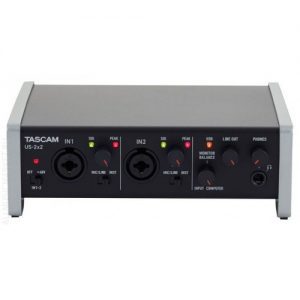
The US sound card line has been on the market for many years now, undergoing regular updates and upgrades.
Only US-366 and US-2×2 are produced from two-channel models. The second is a more interesting option.
First of all, the quality of sound transmission. The device is made in a metal case with massive side panels and weighs 1.1 kg.
Cirrus Logic CS4272 chip acts as a converter. One more interesting feature of the device is the use of branded Ultra-HDDA preamplifiers.
They are implemented only on transistors, without the involvement of operators.
Connection to a computer is made via the USB interface. Power is supplied via the same interface or via a network adapter. Pairing with an iPad is also available.
It requires the Camera Connection Kit to connect to the computer. The connectors are a pair of balanced 1/4″ TRS outputs, two balanced inputs on combined XLR / 1/4″ TRS and a headphone output.
There is a midi interface with standard input and output to DIN5 and phantom power. The US-2×2 has quite a few controls. There is an independent change in the volume level of the line and headphone outputs.
You can change the sensitivity of the left and right channels. You can also use the ability to balance the number of cigars fed to the computer output with the physical inputs of the card.
Mackie Onyx Producer 2×2
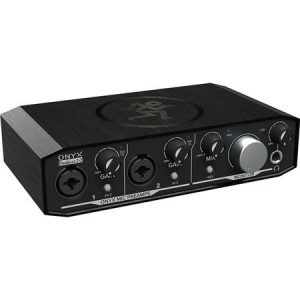
Everything looks thoughtfully. The level control handles have rubber pads that are nice to twist, the hand does not slip.
The change between headphones and speakers is separate. There are two-color indicators that show signal availability and input overload.
Everything has been thought out, and there’s nothing extra. The cabinet design looks typical, but note that you can’t see a single screw in the design anywhere.
The front and back cover is held in place by latches. They are also locked in place with concealed screws underneath the rubber feet.
The inner stuffing is firmly fixed inside with a few bolts, there is no backlash or creaking. The great experience of the manufacturer has had a positive effect.
The models are powered by the USB bus. The largest level of an output signal +10 dBu. The largest level of line inputs +24 dBu. You can quietly connect any studio equipment, the overload will not occur exactly.
The same is true for the guitar input, with the smallest gain knob position of +24 dBu. The microphone input is distorted by less than 0.001%. Inside is the XMOS XU208 processor.
Dual-channel codec CS4272 has parameters: dynamic range 114 dB, Kg + noise -100 dB… The smallest buffer is 64 samples. The 44 kHz mode delay is 8 ms. It is very pleasant to adjust the volume with the analog knob, the stroke is smooth.
The headphone output is quite a good volume, above average.
M-Audio AIR 192|4
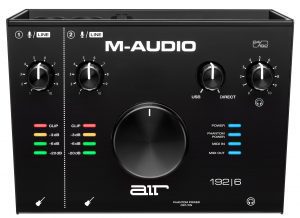
The housing is assembled on a sturdy aluminum plate with a glossy plastic insert on top.
In addition to the rugged construction, the bottom plate of the housing provides shielding for the inside.
All controls are well thought out and at hand. Large, bright picometers allow you to see the signal sign from a distance.
The large volume control knob has a rubber ring and very smooth running. All controls are analog only. When adjusting the level, the interface stands on the table. It does not dangle as it weighs a lot and has rubber feet at the bottom.
The headphone volume control is separated from the check volume. It is very practical. There is hardware monitoring of the inputs labeled DIRECT.
The guitar input is not combined with other inputs and is located on the front panel for easy connection.
The interface is only powered by the USB bus. Two connection cables are included: “USB-C to USB-C” and “USB-C to regular USB”. Despite the USB-C connector, it is the most common USB2.0 interface inside. In other words, it will work from any PC with any USB version.
Here a dedicated amplifier for NCP2811 headphones is used.
All the control is hardware, physical switches, and regulators. So the card has no separate panel. There is a small ASIO panel with buffer selection.
Arturia AudioFuse 8Pre
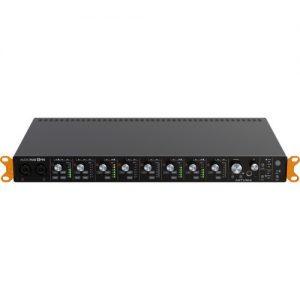
The main emphasis of the company is on DiscretePRO preamplifiers made on transistors according to their own circuit.
They have a very low intrinsic noise, -129 dBu EIN, and a large gain of 72dB. Here, even in the 50% Gaia knob position, you keep the entire signal dynamics.
The inputs have 118 dBA of dynamic range, which is confirmed by measurements in RMAA.
The +24 dBu line input and output signal level makes 8PRE compatible with any studio equipment.
All line inputs have a gate knob to digitize sources with any signal level, even low ones.
Guitar preamplifier mode with the largest signal range of +18 dBu can be enabled on Input 1 and 2. All of Arturia’s grip pens are rubber coated and non-slip.
It is quite convenient that there is a separate adjustable Speaker output. It has the largest dynamic range of 119 dBA. The other non-adjustable outputs 1-8 have a range of 115 dBA. The headphone output has a separate volume knob.
Inputs 1-2 are duplicated at the front for convenience. When connected to the front panel, the two rear connectors are automatically disconnected. Inputs 1-2 can have some sort of side processing on the brake circuit.
Power can only be supplied by an AC power adapter.
8PRE requires a normal USB2.0 bus to connect. No new connectors are required on the computer. Two long USB connection cables are included. Standard USB Type-A on the USB-C and the same USB-C at the ends.
Rode AI-1
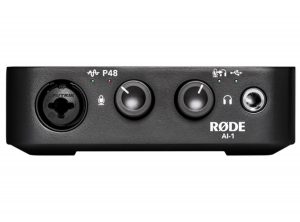
The case of the device is completely metal. It is covered with a rubber-like material. As a result, the case has a very decent weight, is stable and does not slide on the surface.
This device has an ARM STM32F0 microcontroller with a built-in USB 2.0 Full Speed controller.
Here you can use Nuvoton NAU88L25B codec with built-in programmable DSP. The preamplifier is assembled on a discrete transistor circuit.
The gain range is quite average, from 0 to 45 dB. The discrete transistor headphone amplifier has an impressive 390 mW.
Mounting the elements on the mainboard is very tight. The TRS output connectors are mounted on extra board. The microphone and guitar connector of Neutrik combo-XLR has a special stop.
There is also a differential input and an integrated microphone preamplifier. GAIN and VOLUME are available on the front panel. The volume is adjusted simultaneously on the headphone and line outputs.
Pressing the GAIN knob results in a +48V phantom power supply, which displays the red P48 LED. Pressing the VOLUME knob enables hardware Direct Monitoring.
This allows you to listen to the recorded signal in your headphones without any delay. A special LED lights up when the mode is activated. Next to the XLR input, there is also a signal level indicator.
On the rear panel, there is a USB-C connector and TRS balanced outputs to active monitors.
Shure Motiv MVi
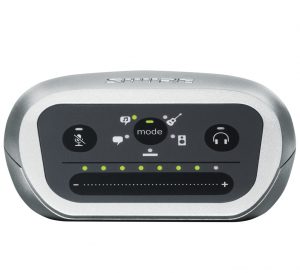
It allows you to connect any studio and concert equipment, any microphones and guitars. Built-in Class A preamplifier provides high-quality sound.
The impedance of guitar input is more than 1 MOhm and swing +9 dBV, which will please guitarists.
Hardware monitoring in headphones allows you to listen to the signal from the inputs.
Shure MVi’s compact digital audio interface is used to connect a microphone. You can also connect a guitar or other instruments to a computer or mobile device.
The interface has a combined microphone and guitar input. It is possible to connect condenser microphones. The microphone input has phantom power. When powered via USB from iOS mobile devices, the voltage is +12 V.
The built-in battery of a smartphone or tablet will not “trickle-down” much. When connected to a PC, the phantom power supply voltage is +48 V full.
Steinberg UR816C
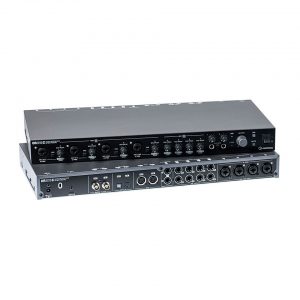
This makes it suitable for quite complex tasks and advanced configurations.
Mode HA Mode allows you to connect two instances of UR816C by optics and use twice as many inputs for recording.
At the same time, synchronization is performed via WordClock. Steinberg UR816C has very strong positions. It offers a large number of microphone inputs.
All inputs are compatible with any equipment, the largest input level is +24 dBu. There are also useful features such as hardware DIM and MUTE buttons on the front panel.
During operation, you can quickly turn down the volume of the phonogram or mute it altogether.
The converter chips here have 32-bit support. They are newer and more interested in sound. They have a wider internal discharge for digital filters and are of higher quality.
Yamaha D-PRE discrete microphone preamplifiers form the basis for microphone and guitar inputs.
On the front panel are combined XLR/TRS 1/2 microphone/guitar inputs and ¾ microphone/line inputs.
Apogee Duet
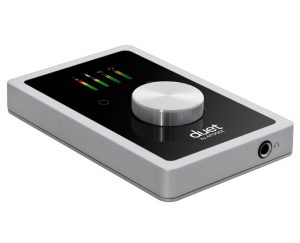
The most popular product of all manufactured by the company is the Apogee Duet USB interface.
The case of Apogee Duet is completely metal, consists of two cast aluminum halves. The large level change knob is also completely metal.
The Duet can be powered by the USB bus. But, to work with low-sensitivity headphones, you need to connect the supplied 15W network adapter.
The color OLED screen immediately catches the eye on the top panel. Perimeter and mode readings are readable from any angle.
This is the merit of OLED technology. Two circles between the screen and the rotary volume knob are the touch buttons. You can assign different functions from a list to these buttons.
By default, the left button clears the peaks at the picketers. While the right button makes MUTE in speakers and headphones. Pressing the volume knob selects the change channel. The step of level change is 1 dB.
A very important feature of the Apogee Duet is the independent headphone output. You can assign the check output to channel 1-2 and the headphone output to channel 3-4. This allows you to output a separate phonogram to the artist’s ears.
Check also 12 Best microphone cables

